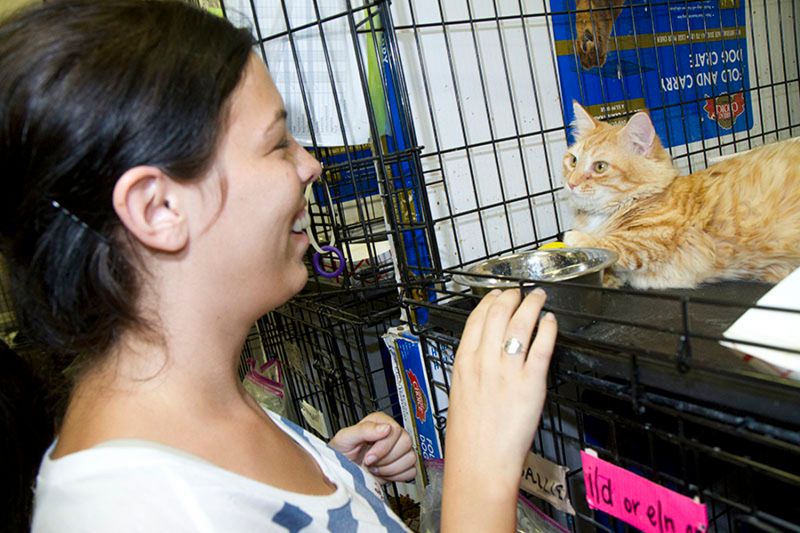Finding a cat a home
Are we missing the good apples while trying to catch the bad?
October 24, 2017

I was traveling recently to conduct a series of Rethinking the Cat trainings in Kansas and Oklahoma through our Humane State program. Having done many of these cat trainings around the country, we hear many of the same concerns, challenges and questions—often with a unique local flair.
Each training has its own feel, and some of that is provided by the venue we are located in. One of our Kansas trainings was at a wonderful host shelter in the state. It had actually been a while since I had been in a shelter for more than a quick tour or meeting. Throughout the day, I had the opportunity to walk through the adoptable cat section as I moved around the building. The rooms had large windows where people could look out onto the cats, and the cats could look right back in at us as we learned and shared more ways to help get them into homes. You all in the trenches have that motivation everyday—fuzzy faces staring at you—but since my workplace is in your typical suburban office building these days, it was both a reminder and an inspiration for me, and made me realize how much I miss working in a shelter.
The training that day was also a bit nerve-wracking, because I was filling in on a presentation I had never given before, since my colleague, Inga Fricke, had to stay back on the East Coast to help coordinate HSUS’ response to the disaster in Puerto Rico. The Adopters Welcome approach is one that I am familiar with and excited about, but watching a colleague give a presentation about it is very different from presenting it yourself! Fortunately, I think the presentation went well, and it also provided me the opportunity to really think about the strategy.
While walking through the facility, with interior windows complete with beds affixed by suction cups, I had the opportunity to see many adorable cats. Adults, kittens and adolescents; orange tigers, calicos and tuxedos; pretty much any color and age combo you can think of. I noticed a small black adolescent cat lounging on one of the window beds; he reminded me of one of my cats, Loki, back home. Later in the day, I walked by him again, and this time noticed the cage cards. One grabbed my attention: “Fleetwood Mac” male, black short hair, 3 months old. What grabbed me was the adorable card, which looked like one of the band’s album covers.
Now it just so happens that Fleetwood Mac is one of my favorite bands and I admit to being a bit of a Stevie Nicks karaoke addict. So, needless to say, I gave that cat a second (and a third) look, texted my husband and started dreaming about him coming home with me. Then reality starting crashing back in: I still had a long week of Humane Kansas trainings to go. How would he handle being schlepped around in a carrier between hotels and venues? Where would I get supplies? Would my two indoor-only cats at home like him? Would he be a good fit? Do we really want to potentially upset the good balance we have right now?
Another element suddenly smacked me in the face. I had just spent an hour and a half talking about the Adopters Welcome approach—finding ways to say yes, instead of no, and I began to wonder: “Would I be a good-enough adopter?” We hear it all the time about our field: “Oh, it is easier to adopt a child than a dog!” and “I went to adopt a cat, but I guess I wasn’t good enough, so I took this kitten from a friend.” How would I stand up to a rigorous adoption application? What adoption policies did this shelter have?
This might be all they see: I am a person making a snap decision, from a far-away state, I rent, and I have a cat at home who is behind on his vaccines. How do I look as a potential adopter? Would your shelter or rescue adopt a cat to me? Would you take the time to talk to me and let me explain my situation and how I could provide a loving and safe home for little Fleetwood Mac? Would I be able to tell you about Loki, who could be termed a semi-feral, and who is slowly getting trained to go into that terrifying carrier, but we’re not there yet?
I made the decision to not pursue adoption that day, for a whole host of reasons, but the questions remained with me. How many “good” homes are we turning away because of an answer on a piece of paper—questions which research has shown has no impact on the outcome of that pet being retained in the home? What sort of message are we sending our community members when we tell them that adoption is the best way to go, and then deny them because they aren’t perfect?
I’m far from perfect, but I know I provide a good home and as much love as my cats will let me give them. Would you take the time to find me a good match—or would I be one of many lost in the shuffle due to policies designed to catch the few bad apples, which a conversation could weed out just as easily?
Do you have a story where you went ahead with an adoption that was less than perfect—and it worked out well? Please share in the comments!

